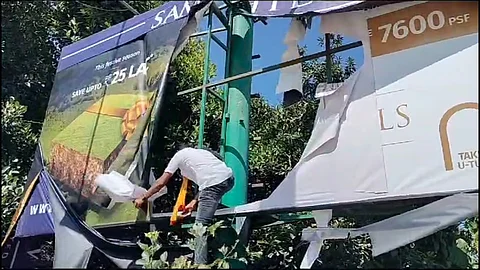

On December 27, activists of pro-Kannada group, Karnataka Rakshana Vedike went around Bengaluru, vandalising name boards, demanding that all shops and establishments follow the BBMP rule prescribing 60% Kannada on all signage. Just three days before this, on December 24, 2023, the Bruhat Bengaluru Mahanagara Palike (BBMP) had passed an order stating that the trade licence of commercial establishments under its jurisdiction will be cancelled, if they fail to feature Kannada prominently on their display boards – occupying as much as 60% of space – by February 28. Law prescribing the primacy of Kannada on signboards is not new. Here’s a look at the various laws enacted by the state government and the BBMP in this regard.
On multiple instances in the past, the BBMP has set deadlines for the use of Kannada in the signage of commercial establishments. In August 2018, the BBMP initiated raids on commercial establishments, enforcing a rule that required 60% of their signage to be in Kannada. Additionally, in 2019, it ordered commercial establishments to adhere to the 60% rule and threatened to cancel their licences if they did not comply, setting a deadline of November 1, 2019.
In December 2008, the BJP-led Karnataka Government under BS Yediyurappa mandated that the name boards of every establishment in the state should also be in Kannada through the introduction of Rule 24 A to the Karnataka Shops and Commercial Establishments Rule of 1963. “The name board of every establishment shall be in Kannada and wherever other languages are also used, the versions in such other languages shall be below the Kannada version. The name board in the Kannada version shall be written more predominantly by providing more space than for other languages, if any,” the rule stated. It also provided for penalties for violations of this rule: “whoever contravenes Rule 24-A shall on conviction, be punishable with fine of ten thousand rupees and for each continued offence be punishable with fine which shall not be less than ten thousand rupees.”
In 2009, Vodafone Essar South Limited went to court against it, demanding that the rule be declared unconstitutional. Vodafone said that the rule would require it to remove all of its signboards that it had spent crores of rupees on and print new ones in Kannada. The company argued that the move “would take away the rights of the petitioner, since the name board 'Vodafone' is used by all over 60 countries throughout the world.”
The single judge bench of the Karnataka High Court ruled in favour of Vodafone, stating that “Rule-24A and 26, are not in consonance with the aims and objects of the Act and are liable to be struck down … Rule-24A and 26 of the Rules, so far as imposing a penalty for violation of Rule-24A, were declared as ultra-vires.”
In 2014, the state government appealed against the High Court order. A division bench that heard the appeal upheld the 2009 order. It stated, “This Court cannot hold that an error is committed by the learned Single Judge, more particularly, in the background of the Act. When an Act is enacted to regulate the working conditions of the common workmen and employees working in the shops and commercial establishments in Karnataka, the State could not have framed the Rules in the manner in which the name board of such establishments shall be there. Therefore, we do not find any merit in this appeal.”
To bypass this, the BBMP in 2018 drafted the BBMP Outdoor Signage and Public Messaging Bye-laws. It detailed all the elements that are to be included on the signage of any shop or establishment, to be put up on the facade facing the main right-of-way. According to the byelaws, of the 10 units (each unit is two words) on a name board, two should be set aside for details like building number; symbol/logo/trademark; licence number; and acronym. Of the remaining units, 60% (4.8 units) should be in Kannada. The remaining units can be used for adding the registered name in the secondary language, the font of which cannot exceed 80 mm.
Later in 2023, the BJP led state government enacted the Kannada Language Comprehensive Development Act, 2022, which stipulated that all nameboards should primarily be in Kannada. Section 17 (6) of the Act said, “The upper half portion of boards displaying the names of Commercial, Industrial and Business Undertakings, Trusts, Counseling Centre‟s, Hospitals, Laboratories, Amusement Centers and Hotels etc., functioning with the approval and sanction of Government or Local Authorities, shall be in Kannada and the lower half can be in any other language.”